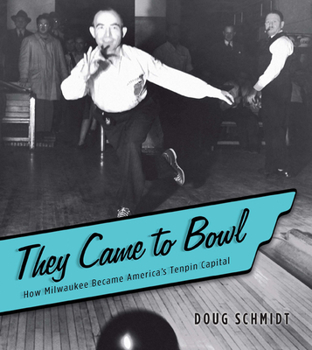They Came to Bowl: How Milwaukee Became America's Tenpin Capital
A frozen rope. A urethane split on the drives. Chicken tracks on the telescore.* Do you know your bowling lingo? You will along with much more when you read "They Came to Bowl: How Milwaukee Became... This description may be from another edition of this product.
Format:Paperback
Language:English
ISBN:0870203878
ISBN13:9780870203879
Release Date:October 2007
Publisher:Wisconsin Historical Society Press
Length:288 Pages
Weight:1.65 lbs.
Dimensions:0.6" x 8.1" x 9.0"
Customer Reviews
3 ratings
They Came to Bowl
Published by Thriftbooks.com User , 14 years ago
It will surprise virtually no one with a Wisconsin background to learn that Milwaukee played a key role in the rise of bowling as a popular recreation. Assisted by a strong German heritage and a love of drinking beer outside the home, Milwaukee took to recreational bowling like few others. It was, relatively speaking, an immediate hit. Beginning around the turn of the century, lanes quickly began popping up - first a few lanes in a few pubs, then several lanes in multipurpose recreation complexes. As the sport became more popular, systematic governance became necessary and Milwaukee supplied many of the important pioneering leaders - serving as the headquarters for some of bowling's most important organizations. Probably even more importantly, Milwaukee supplied more than its share of great bowlers during the sport's heyday. Like everywhere else, bowling declined in popularity in Milwaukee as the millennium drew to its close. No longer were local bowling programs sufficiently profitable, nor were seventy lane bowling centers of much use. Yet bowling remains a significant part of Milwaukee's past and continuing culture. Thanks in large part to the prominence it gave Milwaukee when bowling was king. Doug Schmidt admirably recounts the history of bowling in Milwaukee, principally by introducing the reader to the places, people and personalities that led the way. The stories run the gamut - from tiny basements with two lanes to giant bowling centers with scores of lanes, from quiet and careful businessmen to live-fast, die-young shooting stars. The story probably isn't entirely coherent. Nor will everyone find great interest here - indeed, I struggled through portions where the author highlighted seemingly endless game and series scores. But, Mr. Schmidt successfully retrieves the lost glory of one of Milwaukee's truly glorious pasts. For a time Milwaukee was very nearly the center of the world as far as bowling was concerned, and for an even greater period of time one could not speak of top rank bowling without considering Milwaukee. Mr. Schmidt shows why that was so and tells us who was responsible. Perhaps, this isn't the most important history, but it is fun and it's a piece of the puzzle.
Great book
Published by Thriftbooks.com User , 16 years ago
I have read this book from front to back their is a lot of information that I didn't even know. Specially growing up in a bowling family. Doug informed a lot of history in this book. I am glad he covered a lot. If you look in the back of the book he even have bowling centers from the Milwaukee area listed with all the different names. I was happy that he mention the three guys who shot a 900 series which included my brother PJ. This is a must read book.
They Came to Bowl
Published by Thriftbooks.com User , 17 years ago
Although I have not yet read my copy, I have heard the author interviewed on Wisconsin Public Radio. If his writing is as informative and light as his conversation, this "history" of Germans in Milwaukee and the evolvement of bowling as we know it today will be a great read.






